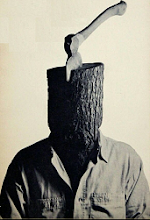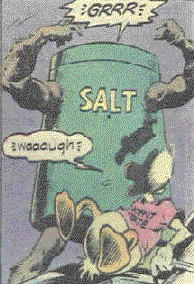The Ten Most Harmful Books
1. The Communist Manifesto, Karl Marx
2. Mein Kampf, Adolf Hitler
3. Quotations from Chairman Mao, Mao Zedong
4. Sexual Behavior in the Human Male (commonly known as The Kinsey Report), Alfred Kinsey
5. Democracy and Education, John Dewey
6. Das Kapital, Karl Marx
7. The Feminine Mystique, Betty Friedan
8. The Course in Positive Philosophy, Auguste Comte
9. Beyond Good and Evil, Friedrich Nietzsche
10. General Theory of Employment, Interest and Money, John Maynard Keynes
Some of these are hard to argue. Mein Kampf, for one. Nietzsche is often lumped in with the fascists, and he had a gawdawful moustache, so okay, I guess its inclusion isn’t so crazy. I’d like to quibble with the inclusion of the Marxist books, but it’s hard.*
Keynes is a bastion of liberal economic thought. Including him was the judges’ way of saying “neener neener” to the liberals of the world. I can appreciate the snark evinced by including it.
But the rest? There lay exposed…scary monsters.
The Kinsey Report? Science, it appears, terrifies the judging committee. “His research doesn’t back our ideology! The truth frightens us! The truth should remain hidden if we don’t like it! Eeek!”
Democracy and Education? Dewey advocated teaching kids how to think, not to memorize stacks of facts, and that to “learn by doing” was the best way. “Think for themselves, rather than only do what we tell them? Eeek!”
I’m not even going to comment on the inclusion of Friedan. You can hear the judges: “Feminism! Uppity women! Eeek!”
Auguste Comte created the discipline of sociology and greatly advanced the philosophy of positivism. In short, he advocated the idea of applying the scientific approach to the study of humanity, rather than adhere to traditional (i.e., strictly religious) explanations and methods. Say it with me: “Eeek!”**
They had a couple of other books that didn’t crack the top ten, but merited “honorable mention.” Some highlights: The Authoritarian Personality (Adorno),*** On Liberty (Mill),**** Coming of Age in Samoa (Mead), Unsafe at Any Speed (Nader), The Second Sex (de Beauvoir), Silent Spring (Carson), and Introduction to Psychoanalysis (Freud).
Going by this list, they find terrifying: communism, fascism, feminism, environmentalism, consumer rights, any form of social science, and…um…anthropology.
There are curious omissions from the list. For example, The Protocols of the Elders of Zion, a book written by the Czar’s government to discredit Jews by labelling them as masters of a vast world conspiracy. The Protocols were used to justify pogroms and the Holocaust, and are still used today to libel the whole of Judaism. I’d call that a harmful book.
They also left out The Turner Diaries, a favorite of American militia nuts. There are a few hundred families in Oklahoma City who would probably argue that Alfred Kinsey exposing the American people’s propensity for unusual sexual practices doesn’t quite compare in impact to The Turner Diaries.
But hey, what do I know? Maybe bringing to light the commonality of homosexuality and promsicuity is, indeed, more dangerous than car bombs blowing up day care centers.
Hm.
No it isn't. It really isn't.
I digress.
There are other harmful books. Other books that present grave dangers to this world. Books that the conservatroid mulletheads of Human Events ignored or overlooked. I do not.
Thus, I present to you:
The True Ten Most Harmful Books of the Nineteenth and Twentieth Centuries.
1. Mastering the Art of French Cooking, Julia Child
Responsible for more bad meals than any other book in history. How many lives have been lost eating the horrors perpetrated by deluded fools thinking they could replicate her sole meunière?
2. Great Expectations, Charles Dickens
Early editions of Great Expectations contained a large spring-loaded steel knife blade that impaled the reader upon reaching page 210. Dickens's "literary device" has slain thousands and horribly wounded tens of thousands more. (Modern editions use a plastic blade, reducing deaths significantly. Still, it remains a dangerous book.)
3. Merriam-Webster Unabridged Dictionary
This mammoth tome has crushed untold numbers of people, mostly children, beneath its elephantine bulk.
4. The Complete Poems of Emily Dickenson
Modern bad poetry began here. Walt Whitman’s Leaves of Grass is also at fault, but the greatest share of blame goes to the Poet of Amherst.
5. The Lord of the Rings, J.R.R. Tolkien
Countless lives have been hopelessly dorkified by Tolkien’s pseudo-epic. When will the madness end? With the slaying of the ORCS and the QUESTING for the MOUNT DOOM and the hoiven with the pain, and the stabbing, and the finger biting off, glaven!
6. Frankenstein: Or the Modern Prometheus, Mary Shelley
My neighbors are building a homunculus out of corpse parts this summer. The entire DC area is overrun with these unnatural half-men, sewn together from cadavers and infused with life drawn from the heavens. Goddammit, Mary Shelley, I blame you for this.
7. The Fountainhead, Ayn Rand
A key element of maturity is the ability to recognize the motivation of others. A child thinks his father makes him mow the lawn because his father hates him. A grown man sees there’s more to it: the old man hates to mow, and dammit, the game’s on. Rand’s binary logic and inflexibility of mind has stunted the intellectual growth of millions by creating an asinine theory of “Reason” based upon a child’s view of the world. "Objectivism" does not survive even the slightest contact with adult reality.
8. The Man Who Knew Too Much, G.K. Chesterton
This nefarious volume encourages people to know too much.
9. Where’s Waldo, Martin Handford
Psychiatric wards contain thousands of victims of Handford’s evil. The Bosch-esque tableaux, the torment of the puzzles, the infernal cruelty writ across the face of Waldo, I swear, if hell itself were ever committed to paper, it would resemble nothing so much as Where’s Waldo.
10. The DaVinci Code, Dan Brown
Not for its crackpot theology or specious history does this book make the list. No. Instead, it cracks the top ten purely on the power of its sucking. Lord, what a crappy novel. Save us all from one-dimensional characters and prose that should embarrass a ten-year old. The power of its suck is so mighty that it infuses nearby objects with suck-waves. If you own a copy, wrap it in aluminum foil to insulate your other books, as well as yourself, from the suck-osity.
Protect yourself and your loved ones from these truly dangerous books.
You have been warned.
------------------------
*Part of me thinks that since Russia was a violent, repressive, backwards police state before the revolution and a violent, repressive, backwards police state after the revolution, blaming the lights of the revolution for the evil seems overkill. Ditto China. Was it a free and open place before Mao took over? Uh, no. It was a repressive empire. Is it now? Uh, no. It’s still a repressive empire and emperors still run the joint. The big difference is that now the emperors wear boring clothes.
Still and all, the Communist flavor of the tyranny can’t be excused or written off.
**Amusing sidenote: Comte invented the word “altruism.” (Insert rude joke about the reason his book is considered dangerous here.)
***They hate this book because it describes them. Really. It does. Heh.
****Mill had the crazy idea that folks should be free to do what they want, provided it doesn’t hurt anybody else. For a group that likes to legislate who can get married and who can’t, Mill advocates treason. For everybody else, Mill makes a lot of sense.
Hell, I’m surprised the Human Events judges didn’t include the Gettysburg Address on the list. ("Government by, of, and for the people? Sounds like a big-government weirdo to me!")
Click here to read more!








